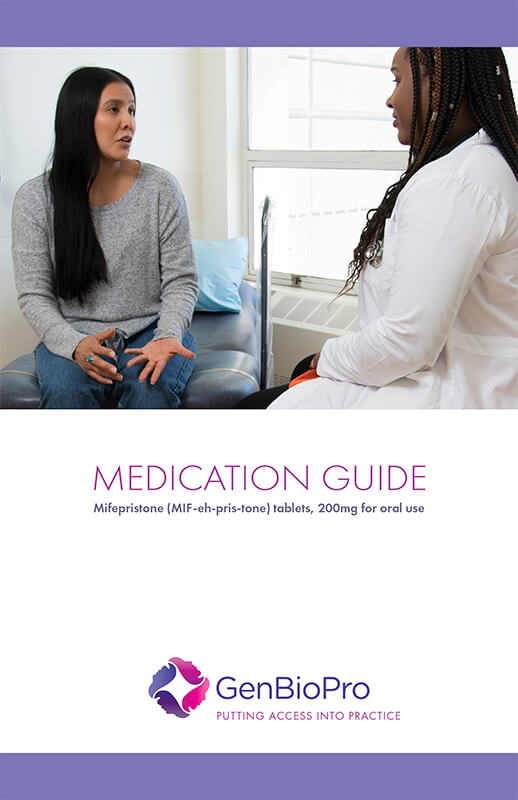Prescribing

Become a GenBioPro Provider to Start Prescribing
To begin prescribing generic mifepristone to your patients, you must first enroll in the GenBioPro Provider Program. It’s quick and easy.
- Step 1: Download a Prescriber Agreement.
- Step 2: Fill out the form as instructed and sign where indicated.
- Step 3: Return the Agreement to the fax number listed on the form.
Our authorized distributor will contact you directly once your account is established and you are ready to order. That’s all it takes to become a GenBioPro provider.
Restricted Prescribing Parameters
Mifepristone is available only under an FDA-approved Risk Evaluation and Mitigation Strategy (REMS) program. The REMS program requires that all GenBioPro providers complete and return our Prescriber Agreement, secure a signed Patient Agreement from each patient, and agree that a certified prescriber will dispense or supervise dispensing mifepristone.
Detailed Requirements for Mifepristone Providers
All providers prescribing mifepristone must:
- Review and understand the full prescribing information.
- Be able to confirm that the pregnancy is within 70 days from the start of the patient’s last menstrual period and that it is uterine, rather than ectopic.
- Walk the patient through the Patient Agreement and Medication Guide and fully explain the medical abortion process and its risks.
- Sign and secure the patient’s signature on the Patient Agreement.
- Provide the patient with a copy of the Patient Agreement and Medication Guide.
- Retain the signed Patient Agreement and record of the serial number from the prescribed package of mifepristone in the patient’s medical record.
- Provide, or direct patients to, facilities equipped for surgical intervention (including blood transfusion or resuscitation) in the event of an incomplete abortion or severe bleeding.
- Contact GenBioPro immediately to report any adverse events, designating the patient by a non-identifiable reference and the recorded serial number from the package of mifepristone.
For more information, review the FDA-Approved Mifepristone REMS Program at
Indication
Mifepristone is used in combination with misoprostol to carry out an early abortion. “Early” is defined as up to 70 days from the first day of your patient’s last menstrual period.
Dosage and Administration
- Provide a 200mg generic mifepristone pill to your patient, to be administered orally.
- Dispense or prescribe 800mcg misoprostol (four 200mcg tablets) to be taken buccally 24-48 hours after ingestion of mifepristone. Tell the patient to place 2 tablets in each cheek pouch for 30 minutes and then swallow any remnants with liquid.
- Provide additional medicine or prescriptions to help manage common cramps or gastrointestinal symptoms.
- Most pregnancies will be expelled within 2-24 hours after the administration of the misoprostol.
- Follow up with your patient 7 to 14 days following ingestion of the mifepristone to assess bleeding and confirm termination of pregnancy.

Preparing Patients for Side Effects
Download the Medication Guide.
Provide your patient with:
- Medicine or prescriptions for cramps, nausea, or diarrhea as desired.
- Instructions on what to do in the event of significant discomfort, excessive vaginal bleeding, or other significant adverse reactions.
- A phone number to call if she has questions after taking the misoprosotol.
- The name and phone number of the health care provider who will handle emergencies.
Contraindications
Administration of mifepristone and misoprostol for the termination of pregnancy is contraindicated in patients with any of the following conditions:
- Confirmed or suspected ectopic pregnancy. Mifepristone is not effective for terminating ectopic pregnancies.
- Chronic adrenal failure.
- Presence of certain steroid medicines.
- Allergy to mifepristone, misoprostol, other prostogladins, or medicines containing them, such as Cytotec or Arthrotec.
- Hemorrhagic disorders or concurrent anticoagulant therapy, which may increase the risk of heavy bleeding.
- Inherited prophyrias.
- Presence of an IUD (intrauterine device or system). It must be removed before the administration of mifepristone.
Warnings and Precautions
Heavy bleeding, cramping, and nausea are common side effects of the mifepristone / misoprostol regimen. The following are serious and sometimes fatal complications, requiring immediate medical attention:
- Infection and sepsis: a sustained fever of ≥100.4°F, severe abdominal pain, or pelvic tenderness may be indications of an infection.
- Uterine bleeding: prolonged heavy bleeding (soaking through two thick sanitary pads per hour for 2 consecutive hours) may be a sign of incomplete abortion or other complications.
Drug Interactions
Some drugs may reduce or increase the exposure to mifepristone:
- Presence of CYP 3A4 inducers, including rifampin, dexamethasone, St. John’s Wort, and certain anticonvulsants such as phenytoin, phenobarbital, and carbamazine. These may induce mifepristone metabolism and impact the efficacy of the dose.
- Presence of CYP 3A4 inhibitors, including ketoconazole, itraconazole, erythromycin, and grapefruit juice, which may inhibit mifepristone metabolism.
- Presence of CYP 3A4 substrates with narrow therapeutic range.
Refer to the Important Safety Information below for further information.
Contact us here or at 1-855-MIFEINFO (1-855-643-3463) or at info@genbiopro.com to learn more about the advantages of becoming a GenBioPro provider, or to request additional copies of the full prescribing information or other resources.

